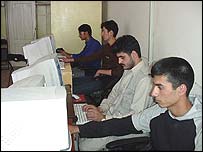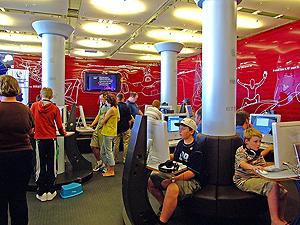Share This:
March 23, 2012 | Theatre,
Café Culture History, Part 5: The History of the Cybercafé
By Magda Romanska
Beginning in the 1990s, many traditional cafés began transforming into so-called cybercafés or internet cafés. The transformation once again reestablished the historical role of cafés as places of public discourse, information exchange and communication. Internet cafés provide internet access to their patrons, usually for an hourly fee. Currently there are two types of internet cafés: those that provide computer terminals with internet access, and those that provide Wi-Fi internet access only, to which users connect via their own computers. The first to install internet access in a café was Wayne Gregori, in 1991 in San Francisco. The concept (and the name Cybercafé), however, was developed three years later, in 1994, by Ivan Pope. Commissioned to design the ‘Towards the Aesthetics of the Future’ art event for the Institute of Contemporary Art (ICA) in London, Pope proposed a café with internet access.

Following the event, Cyberia, London’s first internet café, opened the same year. Shortly thereafter, The Binary Café, Canada’s first internet café, opened in Toronto. Likewise, the same year, the first American internet café, The High Tech Café, was opened by Jeff Anderson in Dallas, Texas. A year later, in 1995, the CB1 Café in Cambridge was established. To this day, it remains the oldest internet café in the U.K. Shortly after its opening, internet cafés began popping up in major urban centers throughout the U.S. and Western Europe. Although their decor and clientele varied, reflecting local culture, cybercafés began developing their own unique variation of café culture while changing the way people began to communicate worldwide. The growth of internet cafés is credited with fueling the internet boom and communication revolution of the late 1990s as more and more people were suddenly able to communicate around the globe in an instant.

In 2008, the world’s first virtual internet café was released in Sweden. The virtual internet café functions similarly to the traditional cybercafé but is fully based on the internet. Instead of using their own computers on the internet, users can remotely control café computers. The virtual cybercafé permits users to have complete anonymity. Today, everyone can set up his or her own virtual cybercafé on the internet for private or community use.
Most recently, as internet use at home has become widespread throughout the West and North America, the use of internet cafés has drastically declined. Since more people now own personal computers, they no longer have a need for communal internet cafés. Many traditional cafés and fast food venues also now offer free Wi-Fi access, so internet cafés are no longer unique phenomena. Interestingly enough, however, whereas in the West internet cafés are becoming extinct, they are experiencing a second renaissance in many developing countries, particularly in Southeast Asia, Africa, and South America, where internet access is sparse. Often, internet cafés are a primary source of internet access for a local community, providing a shared-accessed model, which is more affordable than personal ownership. The function of internet cafés across the globe varies, reflecting the global diversity of internet café culture, from the entertaining-gaming model to the business model to the social and political model, when internet cafés are a vital source of connection in times of political upheaval.

In China, internet cafés are called “wangba,” which means “net bar.” Although few Chinese own personal computers, the internet is booming mainly because of the widespread use of wangbas. In 2005, China had 110,000 registered internet cafés, which employed more than 1,000,000 people. Chinese internet cafés are primarily used for business purposes, gaming and networking. In fact, the use of internet cafés for gaming is popular across Asia, particularly in China, Taiwan, Hong Kong, South Korea and the Philippines. In South Korea, for example, internet cafés are called “PC bangs,” and are frequented mostly by youngsters looking to play online games. The LAN multiplayer gaming centers allow many users to connect to the same portal to play virtual games such as World of Warcraft.

In many places around the globe, like Nairobi, Kenya, for example, people use internet cafés to find love via internet dating sites. But the internet cafés also have their darker side. First, there is a widespread concern about copyright violations by internet café users, which is prompting many café owners to discontinue their CD-burning services. Around the globe, internet cafés are also being used for more sinister purposes, such as connecting global terrorist networks, aiding in the global sex-slave trade and child pornography. In Italy, for example, to prevent the use of internet cafés for terrorist purposes, users are asked for their government issued IDs before logging in. In Singapore, internet cafés are also closely controlled to prevent distribution of pornography. In Los Angeles, internet cafés have been known to attract street gangs; thus their use there has been restricted.


Just as traditional coffeehouses played an important role in spearheading the American Revolution, internet cafés have played an important political role during the recent upheavals, particularly during the Arab Spring, when street demonstrations and information exchanges were organized mainly through the use of internet cafés. In many places, internet cafés provide the kind of cultural exchange that would not be possible otherwise. In Kabul, for example, internet cafés allow for intercity communication which would otherwise take days, as often there are no phone lines available. There is also hope that common access to the internet will empower central governments and unite various ethnic factions, thus bringing people together.
Image 1: Gamers Internet Café in Taiwan
Image 2: Gamers Internet Café in Japan
Image 3: Internet Café in India
Image 4: Internet Café in Nigeria
Image 5: Gigabet Internet Café in England (Image by Flickr user Lee Jordan (cc: by-nc-sa))
Image 6: The ExcelnetCafé in Kabul, Afghanistan
[Images courtesy of Google, BBC News, and Masters of Media.]




Leave a Reply